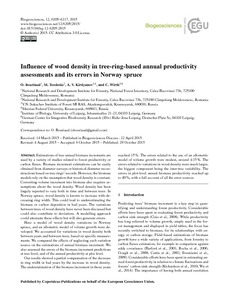Показать сокращенную информацию
Influence of wood density in tree-ring based annual productivity assessments and its errors in Norway spruce
| Автор | Bouriaud, O. | |
| Автор | Teodosiu, M. | |
| Автор | Kirdyanov, A. V. | |
| Автор | Wirth, C. | |
| Дата внесения | 2016-11-11T08:50:47Z | |
| Дата, когда ресурс стал доступен | 2016-11-11T08:50:47Z | |
| Дата публикации | 2015-12 | |
| Библиографическое описание | Bouriaud, O. Influence of wood density in tree-ring based annual productivity assessments and its errors in Norway spruce [Текст] / O. Bouriaud, M. Teodosiu, A. V. Kirdyanov, C. Wirth // Biogeosciences. — 2015. — Т. 12. — С. 6205-6217 | |
| ISSN | 17264170 | |
| URI (для ссылок/цитирований) | https://elib.sfu-kras.ru/handle/2311/27899 | |
| Аннотация | Estimations of tree annual biomass increments are used by a variety of studies related to forest productivity or carbon fluxes. Biomass increment estimations can be easily obtained from diameter surveys or historical diameter reconstructions based on tree rings’ records. However, the biomass models rely on the assumption that wood density is constant. Converting volume increment into biomass also requires assumptions about the wood density. Wood density has been largely reported to vary both in time and between trees. In Norway spruce, wood density is known to increase with decreasing ring width. This could lead to underestimating the biomass or carbon deposition in bad years. The variations between trees of wood density have never been discussed but could also contribute to deviations. A modelling approach could attenuate these effects but will also generate errors. Here a model of wood density variations in Norway spruce, and an allometric model of volume growth were developed. We accounted for variations in wood density both between years and between trees, based on specific measurements. We compared the effects of neglecting each variation source on the estimations of annual biomass increment. We also assessed the errors of the biomass increment predictions at tree level, and of the annual productivity at plot level. Our results showed a partial compensation of the decrease in ring width in bad years by the increase in wood density. The underestimation of the biomass increment in those years reached 15 %. The errors related to the use of an allometric model of volume growth were modest, around 15 %. The errors related to variations in wood density were much larger, the biggest component being the inter-tree variability. The errors in plot-level annual biomass productivity reached up to 40 %, with a full account of all the error sources. | |
| Ссылка на другой сайт | http://www.biogeosciences.net/12/6205/2015/ | |
| Название | Influence of wood density in tree-ring based annual productivity assessments and its errors in Norway spruce | |
| Тип | Journal Article | |
| Тип | Published Journal Article | |
| Страницы | 6205-6217 | |
| ГРНТИ | 34.35 | |
| Дата обновления | 2016-11-11T08:50:47Z | |
| DOI | 10.5194/bg-12-6205-2015 | |
| Подразделение | Научно-исследовательская часть | |
| Журнал | Biogeosciences | |
| Квартиль журнала в Scopus | Q1 | |
| Квартиль журнала в Web of Science | Q1 |

